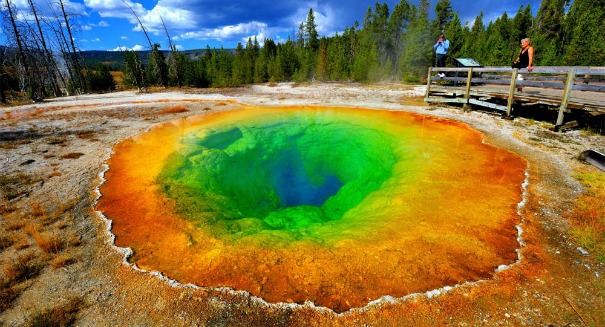
Trash, coins, and other debris have sunk to the bottom and partially clogged the magma vents that heat the pools, causing the temperature of the water to drop, creating microbial mats.
They’re one of Yellowstone National Park’s most iconic attractions: brightly colored bubbling geothermal pools, heated by magma from a simmering volcano below the surface. But they used to be a brilliant blue color many years ago, until humans came along and started throwing trash in them, according to new research.
Hot springs such as Morning Glory, Abyss, Grand Prismatic, Emerald, and Sapphire draw countless visitors each year to gawk at their brilliant color patterns, but little do they know they look that way because many of them have been throwing things into the pool over the years, according to a Discovery News report.
Trash, coins, and other debris have sunk to the bottom and partially clogged the magma vents that heat the pools, causing the temperature of the water to dip into the 140-200 degrees Fahrenheit range, a low enough level for microbes to survive — tiny creatures that are responsible for coloring the surface of the water.
Back in the 1880s when the pools were pristine, explorers who encountered pools like Morning Glory probably found them to be deep blue instead of gold, orange, and green as they are today, according to the study, which was published in the journal Applied Optics. The study was put together by scientists at Montana State University and Brandenburg University for Applied Scientists in Germany, which used a mathematical model using optical measurements to determine how the pools’ colors changed over the years since Yellowstone was established as a park in 1872.
Handheld spectrometers and digital cameras were used along with infrared thermal imaging cameras to determine water temperatures and make comparisons. After feeding the data into a modeling program, they produced drawings that looks very similar to the real thing.
Researchers believe it is the accumulations of trash, coins, and rocks that have partially blocked underwater vents. That led to the formation of microbial mats, which create the colors you can see today. Different colors represent different species of microbes.
Leave a Reply